Procedures - Prosthetics
Implants
Dental implants are used to replace missing teeth that are lost due to tooth decay, gum disease, a bad bite, and trauma (accidents).
With the teeth removed the bone has a natural tendency to atrophy in that area. By placing an implant, the base of the implant (the fixture) will fill the hole left by the tooth root allowing the bone to attach to the implant. But this is only the case for recently removed teeth. If the tooth has been missing for a long time then a bone graft is most likely needed as well to make up for the bone loss.
If you have been missing teeth for some time, you may have lost bone. A bone graft can build up the bone so it can support an implant. When a bone graft is done, bone is added to the area where your jawbone has shrunk.
Implants are placed inside the jaw bone for a period of 4-6 months, and then the crown or denture will be fabricated and attached onto the implants. Here are a couple patient pictures of implants done at our office.
Here are a few patient's pictures of implants done at our office.
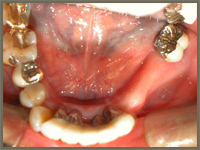
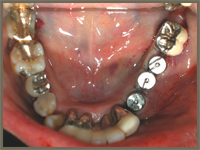


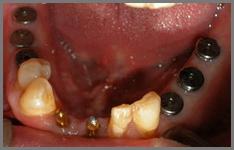

One step of a more comprehensive treatment
This patient had three implants placed, in conjunction with a bridge and veneers for a very different set of teeth.


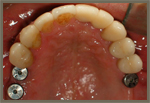
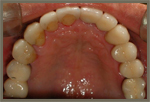
A single Implant site
In this case the first upper molar was extracted due to a fracture. Bone graft was placed and the site was left to heal for six months. Afterwards a 5mm implant was placed and restored with a crown.
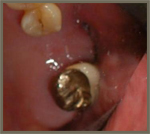
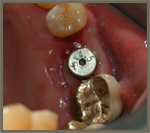
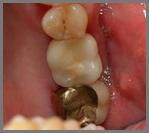
The Implant Denture
 This patient had a regular denture, but opted to have a implant denture, which being attached to the patient's jaw is more sturdy than the regular denture. It makes it's functions more closely to regular teeth, and doesn't feel loose.
This patient had a regular denture, but opted to have a implant denture, which being attached to the patient's jaw is more sturdy than the regular denture. It makes it's functions more closely to regular teeth, and doesn't feel loose.
The advantage of an implant denture is the superb ability during mastication (chewing). The sensation of eating with this denture simulates eating with one's own natural teeth. No more "loose denture"!
Is an implant uncomfortable?
A very common question coming from patients who are in need of implants or about to undergo the procedure.
The implant procedure is a two-phase entity. Provided that sufficient bone is at the receiving site, the actual implant is placed inside the bone and there it stays for several months to allow for integration. The second phase will require re-exposure of the implant and a new crown is made. It is that simple.
All the procedures are rendered under local anaesthetic in conjunction with either oral or IV sedation (for those who are apprehensive). One should NOT feel any more discomfort than you would with a filling.
Keep in mind though that the success of an implant depends on the upkeep of your oral hygiene at home as well as the professional scaling session at your dentist office. Please note that soft plaque can deposit on the implant as well as your natural teeth and therefore maintenance/care is of essence.
Is it expensive to get implants?
Of all the different methods of tooth replacement, an implant would be considered the least invasive as it does not “depend” on the condition of the adjacent teeth per se.
The start up cost maybe marginally higher than a bridge or denture (where you will need to reline at least once a year) but in the long run, it is definitely the first choice of investment!
In addition, the fee for implant can be divided into two stages since several months would have elapsed before the final crown is made.
Many insurance plans now have an “alternative clause” where it would allow some money to be allocated to the placement of implant. Please check your own insurance regarding your coverage.